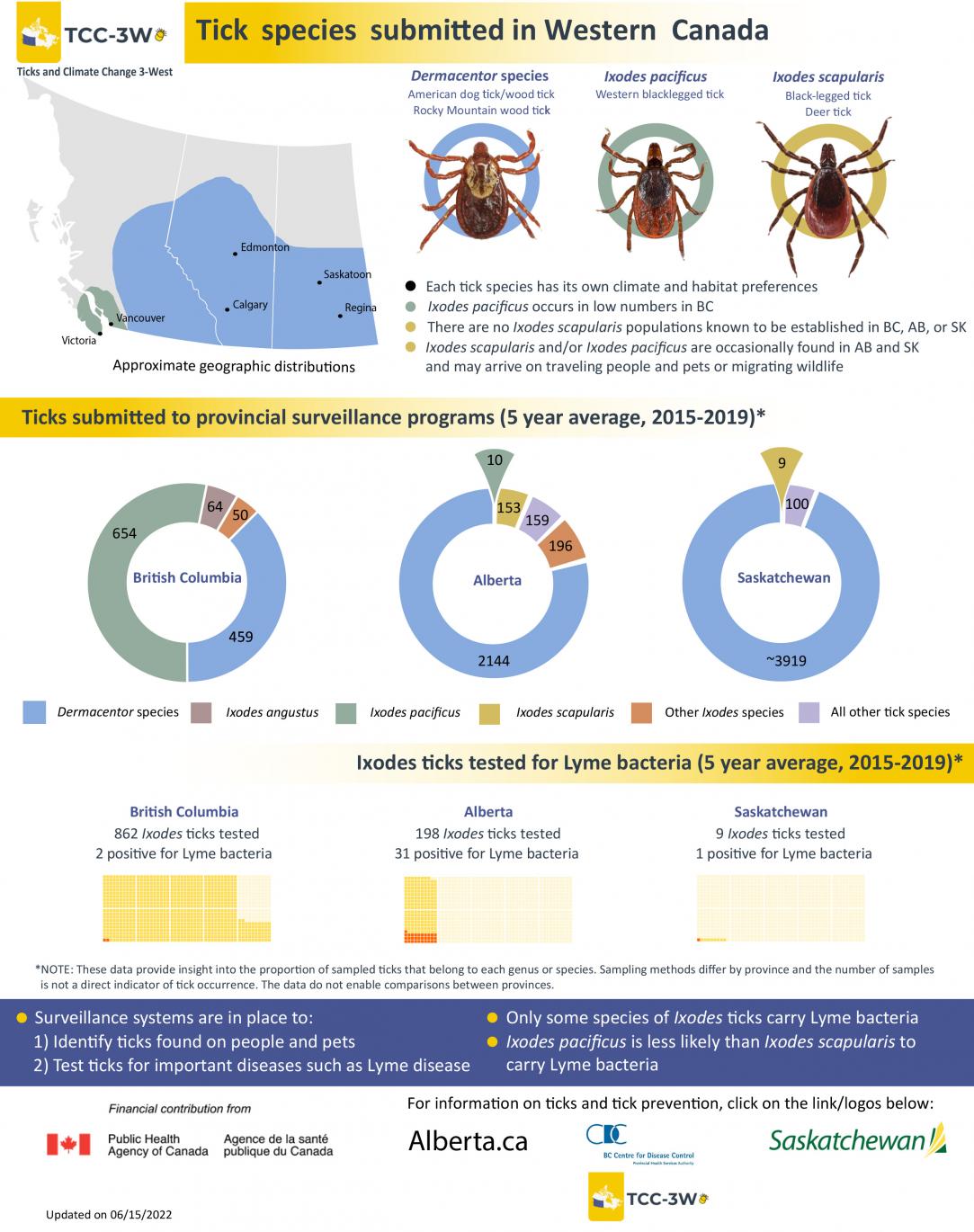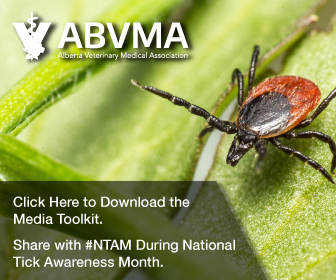You are here
Ticks in Alberta: What You Need to Know

Introduction
Pop quiz: can you identify a tick, and do you know the risks associated with tick bites? Tick… Tick… Tick… Times up. If your answer was anything but ‘yes’, this article is meant for you.
Tick season is considered to be from April to October, however ticks can be active in temperatures as low as 4 degrees celsius and can carry diseases that can make people and pets sick. It is important to think of every season as tick season.
General Information on Ticks
Ticks, small spider-like arachnids, are parasites that secure themselves on a host animal (Human, pet, or wildlife) by biting, and burying their heads deeply under the skin. Tick bites alone pose no tangible threat to the host animal - it is the possible contraction of Lyme disease that makes tick awareness so important.
In an effort to track the spread of Lyme disease within Alberta, and to assess risk to a person or pet after removal, the provincial government began the ‘submit-a-tick’ program. The more people that are aware of ticks and the risks associated with being bitten, the better. The hope is to curb the spread of Lyme disease, and to ensure the highest level of animal welfare.
The most common species of tick in Alberta known to carry Borrelia burgdorferi, the bacteria that causes Lyme disease, is the Blacklegged Tick (or deer tick). The Government of Canada has a resource to help you identify a blacklegged (aka deer) tick.
Lyme Disease
Most tick species in Alberta do not carry Borrelia burgdorferi, however there is evidence that tick species capable of carrying the bacteria are expanding their range throughout Canada.
Lyme disease affects humans, pets, and wildlife. Lyme disease, if left untreated, can cause permanent complications or disability. It is important to note that, although the risk of contracting Lyme disease in Alberta is considered very low. The timely removal and submission of tick(s) is imperative - current understanding tells us that it takes about 36-48 hours before the Lyme disease bacterium can be transmitted to the host.
Tick Prevention
As mentioned above, most ticks alone do not pose a threat to human or animal health, it is important to avoid tick bites whenever possible however to negate the risk of contracting Lyme disease.
It’s also important to note that blacklegged ticks are most often found in wooded or grassy areas.
Some tips from the Government of Alberta on how to avoid ticks include:
- Walk on cleared trails whenever possible and avoid walking in tall grassy or wooded areas.
- Wear light-coloured clothing and cover up as much skin as possible. For example, a hat, a long-sleeved shirt and long pants with the legs tucked into socks or boots.
- Use a bug spray on yourself that contains the chemical DEET or Icaridin to repel ticks and reapply as frequently as directed.
- Check yourself and your pets for ticks after leaving a grassy or wooded area where ticks may live.
- Check your pets for ticks after they have been outside. You cannot get Lyme disease from your pet, but your pet can bring infected ticks inside. These ticks can fall off your pet and attach themselves to you.
Checking Your Pet for Ticks
Bites can often be difficult to detect. Transmission of the bacterium from the attached infected tick takes 36 - 48 hours, therefore it is important to check your pets for ticks every day, especially after they have spent time outdoors. Ticks can almost be too small to see when they first attach themselves to your pets, so check carefully. Signs of tick-borne disease may not be apparent until 7-21 days after a tick bite.
Both dogs and cats are at risk of getting ticks, so it is important to check your outdoor cats just as much as dogs.
This list from the CDC (Centers for Disease Control and Prevention) outlines the process of checking your pet for ticks:
Run your fingers through your pet’s fur with gentle pressure to feel for any small bumps. Looks for ticks in the following areas:
- In and around the ears
- Around the eyelids
- Under the collar
- Under the front legs
- Between the back legs
- Between the toes
- Around the tail
Tick Removal
Source: Lyme Disease Found in Alberta, Please Check for Ticks
If you discover a tick that has bitten your pet, follow these instructions from Alberta Health to remove it safely:
- Using tweezers, gently grasp its head and mouth parts as close to the skin as possible.
- Without squeezing the tick, slowly pull the tick straight up off the skin — do not jerk or twist it.
- Do not apply matches, cigarettes or petroleum jelly to the tick.
- Once the tick has been removed, clean the bite area with soap and water and disinfect the area with an antiseptic. Wash hands with soap and water.
- Save the tick in a clean, empty container. Do not add any ventilation holes to the container that is being used to put the tick(s) in. You can put more than one tick in the container if they are found on the same person or animal in the same general area in the environment.
- Add a small piece of tissue or cotton ball, lightly moistened with water, into the container to prevent the tick(s) from drying out.
- Submit the tick for testing as soon as possible. See below for instructions on how to submit a tick.
If you are uncomfortable or unable to remove the tick yourself, contact your veterinarian for removal, though the earlier a tick is removed the less chance it has to cause infection.
Tick Submission Program
Alberta Health (AH) leads tick surveillance in the province, testing ticks for the presence of the bacteria to better understand the risk of Lyme disease in Alberta. Through a tick submission program, AH monitors the types of ticks that attach to companion animals, livestock and humans, and also those found in the environment. If you find a tick on a person, pet, or in the wild, you can submit a photograph of it to the Alberta Submit-a-Tick program via the eTick website or application.
Currently, only photograph submissions are being accepted to the program. Laboratory testing of ticks for surveillance purposes will commence later this year. Please check back on the Alberta Government webpage for updates and for more information on the new submission process.

Tick Testing and Results
Tests performed on ticks submitted by the public will determine 2 things:
- if it is a species of tick capable of carrying the Lyme bacteria and if so...
- whether the bacteria is present in the submitted tick.
Spread the Word
In Conclusion
If you find a tick outside, on yourself, or your pet, don't be alarmed. If you act quickly and responsibly, you can prevent harm to you or your pet.
Sources & More Information
AAHS: Tick Surveillance and Lyme Disease
Alberta Health Resource: Lyme disease and tick surveillance
Alberta Health Tick Submission Data: Tick Surveillance Results
MyHealth Alberta Lyme Disease: Lyme Disease
Government of Canada, Public Health - Lyme Disease: Lyme disease
Lyme Disease Association of Alberta: About the LDAA
Canadian Lyme Disease Foundation: CanLyme – Canadian Lyme Disease Foundation | Lyme education & research fundraising in Canada
CVMA Resource for Tick Information: Tick Talk: Home
AAHS Lyme disease info: Lyme Disease Found in Alberta, Please Check for Ticks
Tick Report 2020 Alberta: Tick Surveillance 2020 Summary
Alberta Interactive Health Data
CDC: How to Check Your Pet for Ticks | Healthy Pets, Healthy People
CDC: Preventing ticks on your pets | Ticks
| Attachment | Size |
|---|---|
| 1.1 MB | |
| 1.93 MB | |
| 1.59 MB | |
| 1.28 MB | |
| 719.61 KB | |
| 1.78 MB |

